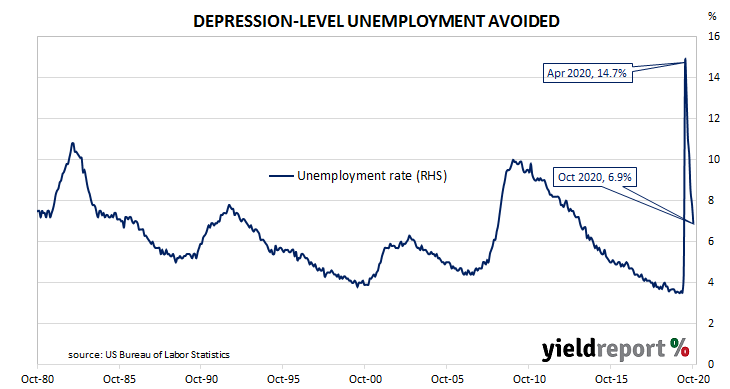Summary: October non-farm payrolls increase by over 600,000; jobless rate drops considerably again despite higher participation rate; “a good set of numbers”; stimulus package “less likely” in final months of Trump Administration; employment-to-population ratio up for sixth consecutive month; underemployment rate down again, still in low-teens; long-term unemployment continues rise.
The US economy ceased producing jobs in net terms as infection controls began to be implemented in March. The unemployment rate had been around 3.5% but that changed as job losses began to surge through March and April. May’s non-farm employment report represented a turning point and subsequent months have continued to provide substantial employment gains.
According to the US Bureau of Labor Statistics, the US economy created an additional 0.638 million jobs in the non-farm sector in October. The increase was slightly above the 0.610 million which had been generally expected but a little less than the 0.672 million jobs which had been added in September after revisions. Employment figures for August and September were revised up by a total of 15,000.
The unemployment rate dropped significantly for a second month, from September’s rate of 7.9% to 6.9%. The total number of unemployed decreased by 1.519 million to 11.061 million while the total number of people who are either employed or looking for work increased by 724,000 to 160.867 million. The rise in the number of people in the labour force increased the participation rate from September’s rate of 61.4% to 61.7%.
NAB economist Tapas Strickland said the figures were “a good set of numbers for sure but with two important implications.” He said an agreement on the latest US stimulus package was “less likely” in the last two months of the Trump Administration and the numbers are dated “given the resurgence in virus numbers and higher frequency data showing consumers are self-isolating even where restrictions have not been tightened greatly.”

Long-term US Treasury yields moved higher on the day. By the close of business, the 10-year US Treasury bond yield had gained 5bps to 0.82% and the 30-year yield had increased by 7bps to 1.60%. The 2-year bond yield finished 1bp higher at 0.16%.
One figure which is indicative of the “spare capacity” of the US employment market is the employment-to-population ratio. This ratio is simply the number of people in work divided by the total US population. It hit a cyclical-low of 58.2 in October 2010 before slowly recovering to just above 61% in late-2019. October’s reading increased for a sixth consecutive month from 56.6% in September to 57.4%.

